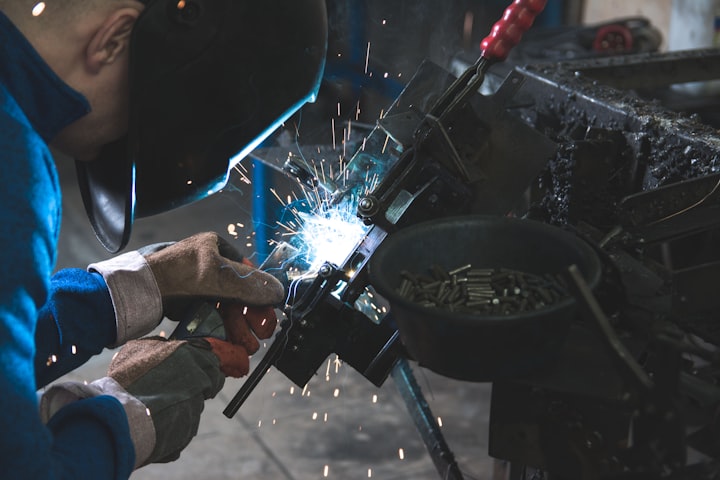Eyes of Protection: Exploring Modern Welding Helmets
Benefits of Modern Welding Helmets

In the world of welding, the adage "safety first" is more than just a saying; it's a guiding principle. Welding is a critical industrial process that fuses metals, creating structures and products that are integral to our daily lives. However, it's a process that poses several hazards, with one of the most significant risks being the intense light and radiation emitted during welding. To protect the welder's vision and overall safety, modern welding helmets like Darth Vader welding helmets have emerged as sophisticated pieces of protective gear. In this article, we will delve into the realm of modern welding helmets, exploring their technology, features, and their crucial role in safeguarding welders' eyes and well-being.
The Evolution of Welding Helmets
Welding helmets have come a long way from their humble beginnings. In the early days of welding, simple face shields provided some protection from sparks and radiant heat, but they offered minimal defense against the intense light and harmful UV and IR radiation generated by welding arcs. Welders were often subjected to painful eye injuries and long-term vision problems.
However, as the understanding of welding hazards grew, so did the need for improved protective equipment. The first significant innovation was the use of shaded lenses, which reduced the intensity of the light but required welders to lift the helmet repeatedly to inspect their work. This was not only inconvenient but also exposed them to the risk of "arc eye," a painful condition caused by overexposure to welding light.
Auto-Darkening Filters (ADF): A Game-Changer
The turning point in welding helmet technology was the introduction of auto-darkening filters (ADFs) in the late 1980s. ADFs revolutionized welding safety by enabling helmets to automatically adjust the shade of the lens in real-time. This meant that welders no longer had to lift their helmets repeatedly, and their eyes remained protected throughout the welding process.
The core components of modern welding helmets, ADFs use advanced sensors to detect the intensity of the welding arc. When the arc is struck, the ADF darkens the lens within milliseconds, blocking harmful light and radiation. When the arc is extinguished, the lens returns to its clear state, allowing the welder to see the workpiece, inspect their weld, or prepare for the next welding pass.
Read More: Welding Helmets Vs Googles
Key Features of Modern Welding Helmets
Modern welding helmets are equipped with a range of features and technologies that enhance safety, comfort, and productivity:
Variable Shade Control: Welders can adjust the shade level of the ADF to match the specific welding process, material, and environmental conditions. This flexibility ensures optimal protection while preventing eye strain.
Sensitivity and Delay Settings: Most welding helmets allow users to fine-tune the ADF's sensitivity and delay settings. Sensitivity adjustments determine how quickly the lens darkens in response to the welding arc's light. Delay settings control how long the lens remains darkened after the arc is extinguished. These settings can be customized for different welding applications.
Battery and Solar Power: ADFs are powered by batteries, typically lithium or alkaline. Many modern helmets also incorporate solar panels that assist in charging the battery. This dual power source ensures that the helmet remains functional even in low-light conditions.
Grind Mode: Some welding helmets feature a dedicated grind mode. When activated, the ADF remains in a light state, allowing welders to switch seamlessly between welding and grinding without removing the helmet. This feature streamlines the workflow and minimizes the risk of eye injuries.
Wide Viewing Area: Modern welding helmets often include a wide viewing area, providing welders with an unobstructed and clear view of their workpiece. This enhances precision and reduces the need for frequent adjustments.
Lightweight Design: Ergonomics play a significant role in welding helmet design. Helmets are engineered to be lightweight, comfortable, and well-balanced, reducing fatigue during extended welding sessions.
Respiratory Systems: Some advanced welding helmets are equipped with integrated respiratory systems. These systems provide a constant supply of clean air to the welder, ensuring protection against harmful welding fumes and enhancing overall safety.
Communication Features: In industrial settings, communication is essential. Some welding helmets come with built-in communication capabilities that allow welders to interact with supervisors and team members in real-time. This is particularly useful in large welding operations or when working in confined spaces.
Conclusion
Modern welding helmets are the embodiment of technological innovation and a commitment to welder safety. They have transformed a hazardous profession into one that prioritizes the well-being of those on the front lines of welding.
With auto-darkening filters, variable shade control, and a host of other features, these helmets not only protect the eyes but also enable welders to work more efficiently and accurately. They are a testament to the progress made in welding technology, ensuring that welders can carry out their craft with confidence and precision.
As welding technology continues to advance, welding helmets will likely incorporate even more features to enhance safety and productivity. From improved ADFs to advanced communication systems, the future of welding helmets holds promise for welders and their vital role in industries worldwide. These helmets serve as the ultimate "eyes of protection," ensuring that the welder's vision remains clear and their safety uncompromised in the challenging world of welding.
About the Creator
Hamza Ahmad
Hamza Ahmad is an SEO Expert and affiliate blogger. I share my knowledge on different topics.






Comments
There are no comments for this story
Be the first to respond and start the conversation.